MercoPress. South Atlantic News Agency
Efforts to protect ozone layer from depletion have been successful, says UN
 Outside Polar Regions, recovery to pre-1980 levels should be reached before the middle of the century
Outside Polar Regions, recovery to pre-1980 levels should be reached before the middle of the century International efforts to protect the ozone layer shielding life on Earth from harmful levels of ultraviolet rays have stopped additional ozone losses, potentially averting scores of millions of cases of skin cancer and eye cataracts, according to a new United Nations report released today.
At the same time they have helped to mitigate the global warming greenhouse effect.
“Today’s report underlines that action to protect the ozone layer has not only been a success, but continues to deliver multiple benefits to economies including on efforts to meet the Millennium Development Goals, MDG” UN Environment Program UNEP Executive Director Achim Steiner said, referring to the ambitious targets that seek to slash a host of social ills by 2015.
Global ozone is no longer decreasing, due to the phase-out of nearly 100 depleting substances once used in products like refrigerators and spray cans, but is not yet increasing. The ozone layer outside the Polar Regions is projected to recover to pre-1980 levels before the middle of the century, although the annual springtime ozone hole over the Antarctic is expected to take much longer, the study reported in one of its key findings.
The report, published jointly by UNEP and the UN World Meteorological Organization WMO and released today on the UN International Day for the Preservation of the Ozone Layer, is the first comprehensive update in four years on the Vienna Convention for the Protection of the Ozone Layer and the Montreal Protocol phasing out chemicals which accelerate both ozone layer damage and climate change.
“It (the Protocol) has protected the stratospheric ozone layer from much higher levels of depletion by phasing out production and consumption of ozone depleting substances,” said the report, written and reviewed by some 300 scientists and launched on the UN International Day for the Preservation of the Ozone Layer.
Given that many substances that deplete the ozone layer are also potent greenhouse gases, the Montreal Protocol “provided substantial co-benefits by reducing climate change,” it added.
In 2010, reductions of ozone depleting substances as a result of the Protocol, expressed in carbon dioxide-equivalent emissions (about 10 gigatons per year), were five times larger than those targeted by the first commitment period (2008-2012) of the Kyoto Protocol, the greenhouse emissions reduction treaty.
“Without the Montreal Protocol and its associated Vienna Convention atmospheric levels of ozone-depleting substances could have increased tenfold by 2050,” Mr. Steiner said. “This in turn could have led to up to 20 million more cases of skin cancer and 130 million more cases of eye cataracts, not to speak of damage to human immune systems, wildlife and agriculture.”
WMO Secretary-General Michel Jarraud said the ozone-hole issue showed the importance of long-term atmospheric monitoring and research, “without which ozone destruction would have continued unabated and might not have been detected until more serious damage was evident.”
In a message for the International Day, Secretary-General Ban Ki-moon cited the Montreal Protocol, which last year achieved universal ratification, as “an excellent example” of setting a broad framework, clear targets and a gradual approach to implementation as governments gain confidence and build on initial steps, setting more ambitious goals.
“When the Montreal Protocol was signed in 1987, governments did not originally envision the phase-out of any ozone-depleting substance,” he said. “Yet, as a result of strong national and global compliance, parties to the Montreal Protocol have cut production and consumption of these harmful chemicals by more than 98%”.




Top Comments
Disclaimer & comment rulesCommenting for this story is now closed.
If you have a Facebook account, become a fan and comment on our Facebook Page!